Okinawa, Japan was once an independent group of islands known as the Ryukyu Kingdom and kings built castles just like Wal-Mart builds shopping centers today. There are around 300 castle ruins, remnants of the 12th through 15th Century castle boom, scattered throughout the Ryukyu chain.
The largest castles were severely damaged or destroyed during World War II and over the past thirty years tremendous efforts have been put forth in restoring them to their original condition. Designated UNESCO World Heritage Sites in the year 2000, they are well maintained and contain a wealth of information for anyone interested in architecture, history, artifacts, photography, culture or just plain, ordinary sightseeing.
The island is only about 65 miles long and the castles are probably within a 40 mile radius of each other, but if you’re really into spending a lot of time researching in one spot; plan on staying a week!
Katsuren-jo

Located on a peninsula jutting out on the Pacific side of Okinawa, this castle was built sometime between the 12th and 13th Centuries.
This is the view of Katsuren-jo (Castle) from across the highway. If you wish to use restrooms or get something to eat, turn back; once you cross the street, you’ll be in a different Century.
The spacious parking lot has a small, air-conditioned museum, an attendant will give you an informative brochure (English) and, everything is free!
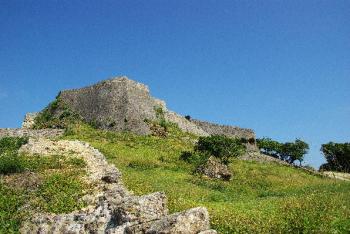
The castle offers a commanding view of the Pacific Ocean, as well as the area in all directions surrounding it. Excavation of artifacts demonstrates that trade was conducted between Japan, China, Korea and all of Southeast Asia.
The climb to the top, walking the entire circumference of the walls and grounds and snapping a few great photos takes less than an hour for most folks.
There’s a Mom and Pop refreshment stand that serves noodles, pastries and ice-cold drinks if you want to sit and rest awhile and work the kinks out of your legs before moving on to see the next monster.
Nakagusuku-jo
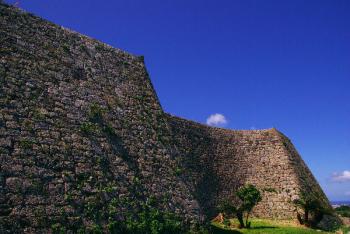
Centrally located, not far from today’s Okinawa City, this castle sits atop 160 meters of rugged cliffs overlooking the Pacific Coast. From the top of its walls you can also see the East China Sea.
An entrance fee of 300 Yen gets you admission and an English language pamphlet with an excellent map and descriptions of the construction, history and cultural significance of what you’re about to encounter.
Inside the walls are several sacred sites where, even today, locals worship their ancestors. Photography is permitted, but discretion is recommended where people are in praying.
It is said that when Commodore Perry visited in 1853, he was impressed with the mortar less construction technique used in building this immense castle.
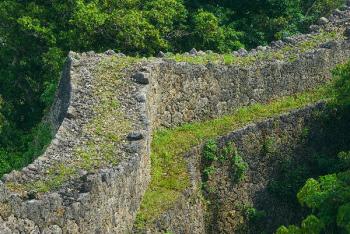
Here is a view from above, facing the northern outer wall. This castle has been kept preserved in its original state more so than any in the Ryukyu chain of islands.
While most of the other restored castle ruins have smooth stone walkways and stairs, this relic has some ankle-twisting, original walks and steps to negotiate. Sturdy footwear; not high heels would be the wise option.
There are six separate, stone-walled enclosures to this sprawling behemoth and you could easily spend two hours navigating the site. The height of the structures, stone archways and trees provide shade from the blistering sun when it gets to be too much for you.
Nakajin-jo

Nakajin Castle is the northernmost of the World Heritage Castle Sites. It is at an elevation of about 100 meters above sea level on a peninsula jutting out from Okinawa’s northwest coast.
A fee of 400 Yen gets you a handy travel guide and access to everything on the site.
It has some sacred prayer sites, a museum; plenty of refreshment stands and hosts a Cherry Blossom Festival during the months of January and February.
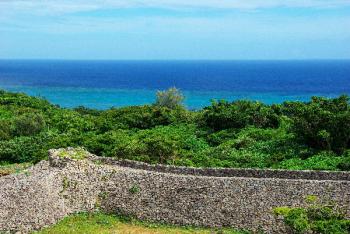
This view is of the wall below, facing the East China Sea.
The exact date of construction is unknown, but it is believed to have been built before the thirteenth Century.
Many of the paths and stairways appear to be the original stone material. A good pair of walking shoes and caution when walking would be wise.
This treasure could easily eat up two hours of your time, especially if you visit the museum.
Shuri-jo

The throne of the Ryukyu Kingdom, Shuri Castle located in the hills above Naha was the center of the kingdom’s trade, culture and politics and in fact, Naha is still the capitol city of Okinawa, today.
Best guesses estimate the castle was originally built during the 12th or 13th Century and records indicate the it was burned-down and reconstructed several times over the years.
In 1945 during the battle of Okinawa, the castle was destroyed. Construction and restoration began in the early 1990’s and today it is the most visited tourist attraction on the island.
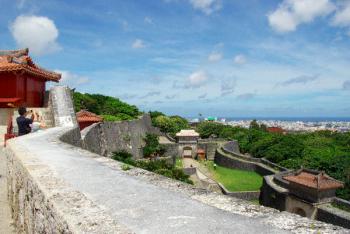
The port and Naha City are visible from the walls of Shuri Castle which overlooks the East China Sea.
This is the only castle on the island that provides some wheelchair accessibility and for those who favor sandals or high heels the Shuri Castle Park is foot and ankle friendly.
An 800 Yen entrance fee gets you in for the day; 1600 Yen will gain you a one year passport for access, so if you’re really an avid castle and culture explorer, you may consider coughing up the big bucks. Kind of like Disneyland, there’s more to this place than you can absorb in just one visit.
Zakimi-jo
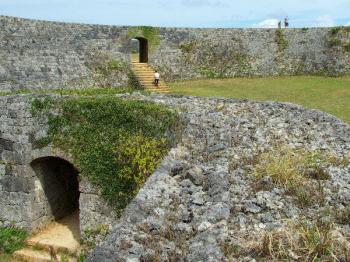
An early 15th Century Castle sits 120 meters above sea level along the Pacific coast and is located in the center portion of the island at Yomitan Village.
This is the only World Heritage castle in Okinawa that rests on red clay footings; all the others were constructed on limestone based mountains.
No entry fee is charged to tour the grounds, here.
In an hour you can tour the entire sprawling complex, capture some great photos, admire the arches and architecture then, go look for some shade; it’s scarce.
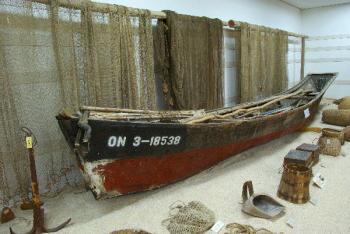
After a visit to the castle, it is well worth the 200 Yen fee charged to enter the museum. Besides being in a climate-controlled atmosphere, there are 400,000 items on exhibit to see, photograph or to study.
Pictured here are some of the items associated with the fishing culture of Okinawa. There’s much more to be seen; artifacts from the Ryukyu Dynasty, farm implements, textiles, art and a few items that’ll make the hair stand-up on the back of your neck!
More info: https://www.wonder-okinawa.jp/002/001/e_index.html
About the author:
Michael Lynch, known in some circles as Ryukyu Mike, is a photographer and writer living in Okinawa, Japan. His writings and photos of Okinawa appear in several magazines.